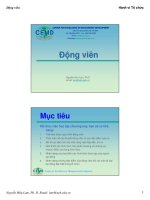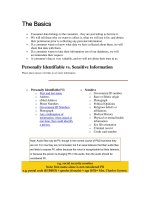Tài liệu Mobile Marketing docx
Bạn đang xem bản rút gọn của tài liệu. Xem và tải ngay bản đầy đủ của tài liệu tại đây (803.7 KB, 20 trang )
Mobile Advertising Overview
APRIL 2008
1.0 Introduction............................................................................01
2.0 Mobile Web ...........................................................................02
2.1 Advertising Overview............................................................02
2.2 Scope of Advertising Guidelines............................................02
3.0 Mobile Messaging...................................................................03
3.1 Overview.............................................................................03
3.2 How to Buy Advertising in Messaging....................................05
3.3 Response Capabilities..........................................................05
4.0 Downloadable Applications......................................................05
4.1 Introduction.........................................................................05
5.0 Mobile Video...........................................................................06
6.0 Who We Are...........................................................................07
7.0 References.............................................................................08
8.0 Contact Us.............................................................................08
9.0 Glossary of Terms...................................................................08
10.0 Appendix.............................................................................09
10.1 Mobile Web.......................................................................09
10.2 Mobile Messaging.............................................................14
The materials found in this document are owned, held, or licensed by the Mobile Marketing Association and are available for
personal, non-commercial, and educational use, provided that ownership of the materials is properly cited. Any commercial
use of the materials, without the written permission of the Mobile Marketing Association, is strictly prohibited.
Mobile Advertising Overview
www.mmaglobal.com
Mobile Marketing Association Version 408
© 2008 Mobile Marketing Association • USA 1670 Broadway, Suite 850, Denver, CO 80202 • UK 28 Broadway, London SW1H 9JX
www.mmaglobal.com
Mobile Marketing Association Version 408
© 2008 Mobile Marketing Association • USA 1670 Broadway, Suite 850, Denver, CO 80202 • UK 28 Broadway, London SW1H 9JX
1.0 Introduction
Mobile advertising is a rapidly growing sector providing
brands, agencies and marketers the opportunity to connect
with consumers beyond traditional and digital media and di-
rectly on their mobile phones. This document is an overview
of the mobile media channels available to advertisers today, in-
cluding the benefits and considerations to optimize campaign
effectiveness and strengthen consumer satisfaction.
The MMA’s Mobile Advertising Guidelines provide global for-
mats, guidelines and best practices to implement mobile ad-
vertising initiatives in a variety of mobile media format cat-
egories including: Web, messaging, downloadable applications
and video.
The Mobile Advertising Guidelines can be located on the MMA
Website at
/>.
Today, mobile phones can be utilized for much more than just
making and receiving calls. Besides voice services, mobile us-
ers have access to data services such as Short Message Service
(SMS), also known as text messaging, picture messaging, con-
tent downloads and the Mobile Web. These media channels
carry both content and advertising.
The mobile phone is an extremely personal device. One
mobile phone typically has one unique user. This makes the
mobile phone a precisely targeted communication channel,
where users are highly engaged with content. As a result, the
mobile channel delivers excellent campaign effectiveness and
response levels compared to other media.
Mobile is valuable as a stand-alone medium for advertising,
but it’s also well suited for a vital role in fully integrated cross-
media campaign plans, including TV, print, radio, outdoor, cin-
ema, online and direct mail. These examples illustrate the
ways brands and marketers use the mobile channel to engage
and interact with consumers:
Click to call (users place an outgoing call to the content •
provider or advertiser)
Click to locate (users find, for example, the closest car dealer •
or movie theatre, enabled by location-based services)
Click to order brochure (users receive marketing materials •
by supplying their postal addresses)
Click to enter competition (users enter text or sweepstake to •
win prizes)
Click to receive email (users receive an email and a link to •
online site by supplying their email address)
Click to receive mobile coupon (users receive an electronic •
coupon on their mobile phone that can be redeemed im-
mediately at a participating merchant)
Click to buy (users make a purchase paid for with a credit •
card, added to their monthly mobile bill or using some oth-
er form of mobile payment)
Click to download content (users download content, includ-•
ing logos, wallpapers or ring tones, onto their mobile
phones)
Click to enter branded Mobile Web site (users click a banner •
to get connected to standing or campaign-specific Mobile
Web site)
Click to forward content (users forward relevant content to •
friends, creating a viral campaign effect)
Click to video (users click a banner to view an advertiser’s •
commercial for a product or service)
Click to vote (users reply to a ballot or poll from their mo-•
bile phone and provide marketers and brands with valuable
research insights)
When designing a mobile advertising campaign, it’s important to re-
member that there are multiple channels for reaching the consumer.
In the mobile environment, those include Mobile Web sites, down-
loadable applications, mobile messaging and mobile video, all of which
can be integrated into the interactive campaigns previously described.
Each campaign type can link to additional mobile content or chan-
nels, as well as to complementing traditional media. Mobile provides
a powerful instant and interactive response path, such as consumers
sending a keyword to a short code via SMS, or registering on
a Mobile Web site.
Channel Description
Advertising
Opportunities
Mobile
Web
The Mobile Web offers users the ability to do
such things as play games and trivia, search
for information, look up telephone numbers and
addresses and do their banking and shopping on
their wireless phone.
Banner ads on
Mobile Web sites
Text ads on Mobile
Web sites
Branded Mobile
Web sites.
Good for:
Driving users to a
Mobile Web site
Lead generation
Direct sales
Branding
Down-
loadable
Applica-
tions
Software or content that consumers download
to their mobile phone and then resides on the
phone. Examples include applications such
as games and lifestyle tools. Downloads are
accessible to consumers with appropriate mobile
phones and data plans.
Ad placement
within applications
(e.g., banners,
“splash” pages)
Branded applica-
tions.
Good for:
Branding/CRM
Driving users to a
Mobile Web site
Page 1
Mobile Advertising Overview
of 17
www.mmaglobal.com
Mobile Marketing Association Version 408
Page 2
Mobile Advertising Overview
of 17
© 2008 Mobile Marketing Association • USA 1670 Broadway, Suite 850, Denver, CO 80202 • UK 28 Broadway, London SW1H 9JX
Channel Description
Advertising
Opportunities
Mobile
Messaging
This category includes SMS and Multimedia
Messaging Service (MMS). SMS is available to
virtually all mobile phone users and does not typi-
cally require a data plan or Mobile Web access,
making it ideal for reaching most mobile users.
While SMS is limited to contain text, MMS can
contain images, audio and even video content.
Most mobile phones sold over the past few years
support MMS, making it an effective way to
reach many mobile users. Interactive applica-
tions frequently use SMS with common short
codes (CSC), which are four- to six-digit phone
numbers to/from which messages can be sent/
received. (For more information about the United
States CSC program, download the MMA’s Short
Code Primer, available at />shortcodeprimer.pdf).
Text ads (SMS,
MMS)
Branding/CRM
(SMS, MMS)
Banner ads, splash
pages (MMS)
Animated images
(MMS)
Good for:
Driving users to a
Mobile Web site
Click to call
Branding/CRM
Interactive dialogue
(e.g., voting, polling)
Mobile
Video
Video delivered over a mobile network to the
mobile phone’s embedded media player. Videos
may be downloaded or streamed and are usually
accessed from a Mobile Web site or contained
in an MMS message. Mobile video is accessible
to consumers with Mobile Web enabled mobile
phones and data plans.
Video ads in
pre-roll, mid-roll or
post roll.
Static images,
animation or video
Branded videos
Good for:
Branding/CRM
Driving users to a
Mobile Web site
Click to call
2.0 Mobile Web
2.1 Advertising Overview
The Mobile Web is fast emerging as a mainstream information,
entertainment and transaction source for people on the move and
away from a PC. Browsing the Mobile Web is similar to tradi-
tional PC-based Web browsing and provides users with access to
news, sports, weather, entertainment and shopping sites.
However, there are some significant differences between PC-
based access and phone-based access:
The mobile phone is a highly, targeted device with typically •
one user. As such, powerfully accurate and relevant com-
munication messages can be delivered where users become
instantly engaged with campaigns and content resulting in
increased campaign effectiveness.
The environment in which people interact with their mo-•
bile phone does not lend itself to detailed information search
and delivery. Instead, mobile users seek quick and conve-
nient access to information and services when they are out
and about. Space on the mobile phone screen is at a pre-
mium, and users have limited input mechanisms, so Mobile
Web sites need to be easy to navigate using just the mobile
phone keypad.
Today’s mobile phones have a broad range of different form •
factors, screen sizes and resolutions, all of which presents a
challenge for the display and optimal viewing of content and
advertising. This document’s recommendations directly ad-
dress this challenge.
Many operators provide a “home page” that is configured to work well
with their subscribers’ browsers. The operator portal (also known as
the carrier’s “deck” or on-deck) provides a variety of links to branded,
mobile-specific external sites to make it easier for subscribers to navi-
gate. Increasingly, mobile users browse outside their operator portal.
These “off portal” or off-deck sites are becoming important destina-
tions for Mobile Web browsing, with sites such as Yahoo!, Facebook,
BBC and Sky offering tailored mobile experiences.
How do I buy advertising on the Mobile Web?
Buying advertising on the Mobile Web is similar to buying display
advertising on the Internet. Graphical, interactive display ads are the
predominant ad unit. Although, in most cases, Mobile Web banner
ad impressions can be purchased on a cost per thousand (CPM) or a
cost per click (CPC) basis, mobile offers targeting possibilities beyond
that of traditional media. As this develops further, we would expect
to see a range of targeting options made available covering context,
demographic and behavioral attributes. Any targeting options made
available will comply with existing national level, legal and regulatory
frameworks governing privacy and personal data.
Some operators and publishers that have Mobile Web sites sell mobile
ads directly, while others allow their inventory to be sold by a third
party, either as premium inventory or as part of a mobile ad network.
The biggest difference between buying Mobile Web display ads and
Internet display ads is that Mobile Web ads are not sold by unit size.
Because the sizes and resolutions of mobile phone screens vary, the
way the content looks on those mobile phones will also vary. The
sizes of Mobile Web banners as defined in the MMA Mobile Advertis-
ing Guidelines (
are optimized to best fit the mobile phone on which the ad is being
viewed. This improves the user experience, ad readability, creative flex-
ibility and effectiveness. This is why many publishers and ad networks
may ask you to provide multiple versions of your banner creative with
your Mobile Web campaign.
What results can I expect?
The success of a mobile advertising campaign can be measured in a
variety of ways. The main measurements are impressions and click-
through rates. Additional measurements include conversion rates,
such as click-to-call rates and other forms of interactive measurement.
These performance results will vary by campaign type, messaging and
calls to action. However, most mobile campaigns today result in signif-
icantly higher click-through rates than PC-based Internet campaigns.
2.2 Scope of Advertising Guidelines
Today’s mobile phones are becoming increasingly sophisticated, with
www.mmaglobal.com
Mobile Marketing Association Version 408
Page 3
Mobile Advertising Overview
of 17
© 2008 Mobile Marketing Association • USA 1670 Broadway, Suite 850, Denver, CO 80202 • UK 28 Broadway, London SW1H 9JX
high-resolution screens, sophisticated Mobile Web browsers, MMS
support and high-speed access, all of which allow high-quality and
media-rich Mobile Web ad banners. To give marketers and brands an
opportunity to leverage these improvements, the MMA’s Mobile Adver-
tising Guidelines examine the properties of Mobile Web ad banners.
3.0 Messaging
3.1 Messaging Overview
The basic idea behind mobile messaging technology is to enable us-
ers to communicate in an asynchronous manner, where messages are
stored in the network and delivered to the recipient as soon as the
recipient’s mobile phone can receive it.
SMS (Short Messaging Service) has grown to be the single most
frequently used mobile data service. This service is also referred to
as “text messaging” or “texting”. SMS is a messaging infrastructure
that allows a mobile user to send and receive a text message of up to
160 characters and across virtually any operator network. All mobile
phones shipped over the past few years support SMS. As a result, the
large installed base of SMS phones creates a large addressable market
for SMS-based mobile marketing campaigns.
MMS uptake is growing as multimedia-capable mobile phones
spread in the market. MMS allows mobile users to exchange
multimedia messages - typically picture, audio and/or video in
combination with text.
SMS and MMS services are together referred to as “Mobile Messag-
ing.” The key differences between the two are that SMS is text only,
while MMS offers rich media content. SMS communication is sup-
ported between different networks and between different countries,
while MMS still faces obstacles in many places when it comes to send-
ing messages between networks and countries. However, the stickiness
of Mobile Messaging, the enormous reach of SMS and the rich media
capabilities of MMS make this channel a highly rewarding advertising
opportunity.
Newer forms of mobile client-based messaging services (e.g., mobile
email, mobile instant messaging) are not addressed in these guidelines.
Those messaging services are at different stages of deployment and/or
evaluation and have lower rates of adoption in mass markets than SMS
and MMS. They may be addressed in future editions.
Editor’s Note: The MMA Mobile Advertising Committee is in-
troducing an initial draft of MMS guidelines and best practices,
available at
The MMA anticipates the MMS section will quickly evolve as the
industry and the MMA committee continues to define enhancements
to the global guidelines and best practices (to be released in subse-
quent biannual or interim releases).
3.1.1 Messaging as an Advertising Medium
Mobile messaging represents an opportunity for advertising place-
ment. Media publishers are using messaging to distribute mobile
content. Businesses are providing consumer services through
mobile messaging. These messages provide inventory into which
advertisements can be inserted. In addition, it is now possible to
purchase advertising in personal – person-to-person (P2P) – SMS
and MMS messages.
There are two primary types of advertising inventory:
Application-to-Person (A2P): This type of inventory includes
SMS and MMS messages sent by a business or other organization/
entity via an automatic application to a consumer’s mobile phone.
In many cases, the consumer may interact with the application
through messaging. It is possible to insert advertising on this type of
inventory, provided there is sufficient space left within the message.
A2P messaging is used for a wide range of services:
Push Content Services –• Media publishers use SMS and
MMS to send requested content (e.g., news, sports, jokes, gos-
sip) or information to their users. A user can subscribe to
these services on a daily or weekly basis, or request it on an
ad-hoc basis. For example, CBS News has an MMS news alert
program for Verizon Wireless subscribers, and Fox25 distrib-
utes American Idol pictures and content via MMS to AT&T
Mobility subscribers. USA Today provides daily weather fore-
casts delivered by SMS. Content service providers deliver
their product via a mobile message, such as with ring tones,
wallpaper, pictures, music and video. Ads can be inserted in
SMS content that subscribers request and receive by using the
free (non-used) space, up to the character or message size lim-
it. Users typically receive free or subsidized content in ex-
change for viewing these ads.
Business Services and CRM – • Businesses may use mobile
messaging as a customer communication element of their
core product offering. For example, a bank may offer text
message alerts when an account drops below a certain balance,
or an auto dealer may offer reminder messages when a vehicle
is scheduled for routine service. Wireless service providers use
messaging (today, mainly SMS) to notify subscribers of service
events such as voice mail, network coverage, transaction con-
firmations, roaming network welcome messages or account
status (e.g., prepaid balance, loyalty points). Ads can be in-
serted in SMS or MMS alert service content using the free
(unused) space, up to the respective size limits. This may come
in return for some value offered by the service provider. For
example, Vodacom SA has announced it is selling text adver-
tising on its free to consumer and ad-supported “please call
me” message service, which it claims to generate up to 20 mil-
lion messages a day.
Search and Inquiry Services –• Media publishers or search
service providers use SMS and MMS to send information in
response to user inquiries. These include directory inquiries
for store locations, or phone numbers, price search services,
www.mmaglobal.com
Mobile Marketing Association Version 408
Page 4
Mobile Advertising Overview
of 17
© 2008 Mobile Marketing Association • USA 1670 Broadway, Suite 850, Denver, CO 80202 • UK 28 Broadway, London SW1H 9JX
and a large variety of other search-via-mobile services. The
inquiry is typically invoked by texting commands and/or key-
words to short codes. Ads can be inserted in the free space in
the message, up to the character or size limit of the message.
Interactive Services – • Interactive services let users partici-
pate in voting, polls, contests or to become engaged with
communities through chat or billboard arrangements. Often
those services are integrated with other media activity, such as
TV shows or print campaigns. Users are invited to vote and
typically receive an automated response, which may also in-
clude advertising. Ads can also be inserted in messages re-
ceived by interactive chat participants. These ads can be in-
serted in the free space in the message, up to the character or
size limit of the message.
Additionally, A2P inventory includes messages that are part of a
direct mobile marketing, advertising or promotional campaign.
For example Doritos/Frito-Lay invited consumers to text unique
codes found inside product packaging to the campaign’s short
code, in order to win prizes. The objective of this campaign was to
drive Doritos product sales. This type of mobile message does not
typically include additional inserted advertising because the entire
purpose of the message is advertising or marketing and therefore is
not addressed in these guidelines.
P2P: This inventory consists of personal messages sent between users.
The original purpose of messaging was to enable users to communi-
cate amongst themselves. Today, SMS is the most widely used mobile
phone service after voice. In some countries, it is used by more than 80
percent of mobile subscribers (e.g., 86 percent in the United Kingdom
according to a July 2007 M:Metrics survey).
It is possible to insert ads in the available space in personal messages, up
to the message size limit. Advertising insertion in P2P messages is not
commonly used today; however, some operators are rewarding sub-
scribers that are willing to receive ads within the messages they receive
from their friends with discounts on activities such as sending MMS/
SMS. The potential P2P inventory is enormous.
Across many markets, there will be existing national level regulatory
and legal frameworks outlining acceptable uses of this channel. In par-
ticular, the use of any personal data and/ or any use of content of P2P
messages will require careful examination to ensure adherence to na-
tional privacy laws. In addition, end users concerns and expectations
will always need to be carefully managed. Taking all steps necessary to
ensure end customers fully understand any proposal to use their data,
together with providing a clear choice to opt in or out of this type of
service, is essential for its long-term success.
3.1.2 Complete Messaging Advertising
These standards are designed to address advertising that is in-
serted in other user-requested content, such as account notifica-
tion or entertainment messages. However it is possible to also
send mobile messages that contain purely advertising or market-
ing content. These guidelines do not address this type of mobile
marketing or mobile promotions. Broadcast of mobile marketing
messages should follow the MMA Code of Conduct, available at
/>3.1.3 Success Drivers
The following key characteristics drive the success of messaging as a
source of mobile advertising inventory:
Ubiquitous SMS access – Virtually all mobile phones can re-•
ceive SMS, and the majority of users use SMS on a regular
basis. Today, SMS is the most widely used mobile phone ser-
vice after voice.
Growing MMS access - MMS adoption levels are signifi-•
cantly lower than SMS, but even in developing markets,
more than 70% of mobile phones can receive MMS. The
MMS market continues to grow in both developed and
developing markets.
High attention level – Users almost never delete mobile •
messages without opening them and reading at least parts
of the content.
Simplicity – Despite the sometimes limited creative space, ads •
are usually easy to develop, particularly for one-step campaigns
where advertisers send either coupons or codes for discounts
or samples of specific products or services.
Engaging – Once displayed, messaging ads can engage users •
directly in various ways, such as interactive message reply/
forward, click-to-Mobile Web and click to call.
Compatibility – Messaging usually works between different •
networks and between different countries. However, MMS
still faces some obstacles in this area.
Propagation – The viral effect is especially strong, with re-•
sponse rates being boosted by recipients qualifying and for-
warding messages to people with high relevance, as deter-
mined by the initial recipients.
Tracking – Ability to measure channel usage, track unique ad •
exposure and obtain detailed results analysis.
Response collection is easier – It also may be achieved im-•
mediately. Brands may have access to real-time response infor-
mation and may modify the campaign according to the results,
long before a campaign terminates.
Easy to integrate into 360•
o
communication – The effective-
ness of a campaign may increase if mobile messaging is used
seamlessly integrated with other media.
Direct and personal way of communication – Customer has •
the sense of feeling that the ad addresses only him/her.
www.mmaglobal.com
Mobile Marketing Association Version 408
Page 5
Mobile Advertising Overview
of 17
© 2008 Mobile Marketing Association • USA 1670 Broadway, Suite 850, Denver, CO 80202 • UK 28 Broadway, London SW1H 9JX
3.2 How to Buy Advertising in Messaging
3.2.1 SMS Advertising
SMS advertising is defined as ad units that appear appended to
other published content or as a full advertising message. The
ad unit can either be static (no action can be taken by the end
user) or dynamic (user can act on the message).
Buying advertising in SMS is similar to buying text-based ad-
vertising on the Internet. In most cases, SMS ad impressions
can be purchased by CPM deliveries. Typically, publishers and
service providers either sell their own inventory in A2P SMS
messages or work with an SMS advertising network, which
places advertising in existing SMS content feeds.
3.2.2 MMS Advertising
MMS advertising is defined as ad units that appear inserted
to other content. The ad unit can either be static (no action
can be taken by the end user) or dynamic (user can act on the
message, e.g. by clicking).
MMS advertising is new, and it creates opportunities for rich media
ads, including video and sound. That said, buying advertising in
MMS is similar to buying banner advertising on the Internet. In
most cases, MMS ad deliveries are purchased by CPM.
3.3 Messaging Response Capabilities
SMS/ MMS response capabilities are grouped into three different cat-
egories: message-based, call-based and WAP-landing-page-based.
3.3.1 Message Based Responses
The user can reply to the SMS/MMS with a message. The
response number appears as part of the text on the message
or as the “from” address area, where it can be replied to
directly. Where the number is embedded, the mobile phone
can usually extract the number from the message. The fol-
lowing types of reply messages can apply:
Opt-in to receive messages•
Text in to receive more information, such as sample content•
Text in to enter a sweepstake•
Text in to participate in a customer survey•
Text in to vote •
Text in to refer to friend•
Text in to buy•
Text in to locate a nearby location•
Text in to receive the promotion•
3.3.2 Call Based Responses
From an SMS/MMS message, the subscriber can click and
make a phone call directly. The consumer may interact with
a live operator, or the following interactive voice responses
(IVR) are possible:
Call in to vote •
Call in to buy•
Call in to get more information (e.g., about loans, new products)•
Call in to renew a plan•
Call to complete survey•
Call in to chat•
Call in to receive the promotion•
3.3.3 Mobile Web Landing Page Responses
From an SMS/MMS message, the subscriber can click on a WAP link
and be directed to a WAP site. These responses are identical to the ban-
ner ad responses presented in the Mobile Advertising Guidelines available
at
4.0 Downloadable Applications
Mobile downloadable applications are a fast-developing segment of
the global market. Consumers are habitually opting into subscription-
based models increasing the usage and market opportunity for down-
loadable applications.
Editor’s Note: The Downloadables section is a result of commit-
tee output and collaboration from the North America branch of the
MMA and includes best practices for advertising within mobile down-
loadable applications. The MMA anticipates that best practices and
guidelines for downloadables will continue to evolve as we strive for
global endorsement and collaboration on the guidelines.
4.1 Introduction to Advertising
Mobile downloadable applications are pieces of software that are resi-
dent, either in whole or in part, on the mobile phone. Downloadable
applications are most often used for interactive experiences, including
playing games (e.g., Tetris, DinerDash) and using applications/lifestyle
tools (e.g., Zagats, Moviegoer). Mobile downloadable applications are
usually downloaded over a wireless network directly to the mobile
phone but can be uploaded via Bluetooth or cables, as well.
Mobile downloadable applications are developed using platforms such
as Java 2 Micro Edition (J2ME), Binary Runtime Environment for
Wireless (BREW), Symbian, Windows Mobile and Palm; these vary
by operator. Mobile downloadable applications are optimized by plat-
form and by mobile phone to ensure an optimal experience for each
individual user.
Purpose
Define standard ad units to be displayed within applications on •
mobile phones when advertising is not directly integrated into
content, an “advergame” or customized advertisement per the
advertiser or brand partner.
Define basic parameters for the customer experience based on •
current best practices.
www.mmaglobal.com
Mobile Marketing Association Version 408
Page 6
Mobile Advertising Overview
of 17
© 2008 Mobile Marketing Association • USA 1670 Broadway, Suite 850, Denver, CO 80202 • UK 28 Broadway, London SW1H 9JX
Identify the unique aspects of downloadable applications, •
such as client-server architecture and intermittent connec-
tivity that make downloadable applications function differ-
ently than Mobile Web sites.
Create counting and reporting guidelines that keep this connec-•
tivity in mind.
Encourage general scalability within standard formats for a •
lower barrier to entry into the mobile downloadable ad-
vertising market.
General Principles
For ad formats that translate between the Mobile Web and •
downloadable applications, the primary goal is to remain as
consistent as possible with much of the Mobile Web guide-
lines defined in the Mobile Advertising Guidelines available at
This con-
sistency will drive adoption and scale through broad reach
across mobile phones and minimize creative production
expense for agencies/brands.
Educate the mobile advertising ecosystem about the cre-•
ative guidelines that enable broadest reach across mobile
phones, through standard units. This will allow advertisers
that have purchased only Mobile Web ads to re-use those
creatives.
The intent is not to address highly integrated advertising adver-•
gaming or custom advertising. These will always be tailored solu-
tions created by publishers and advertisers. The industry should
encourage these experiments as long as the customer experience
isn’t compromised.
Advertising must not degrade the application’s user experience. •
This ensures continued usage of the application, continued pur-
chase of mobile ad space and customer satisfaction.
Advertising that is disruptive, takes over a user experience •
or takes a user out of an application must notify the user
before this occurs. For example, there should be a notice
such as: “You have asked to exit the application. Are you
sure you want to do this?”
Current and Emerging Downloadable Application Marketplace
Currently, many downloadable application advertising cam-•
paigns are associated with a particular product rather than a
particular ad unit size.
Because the industry had no preliminary downloadable ap-•
plication guidelines until recently, existing implementations
may not be compliant with these recommendations.
Many downloadable application advertising campaigns are •
highly integrated and contextual to the application or
game.
Networks for downloadable application advertising are •
emerging, as are campaigns that include multiple advertisers
by product.
It is possible to have to work within more granular segmen-•
tation, either by content type and genre or by mobile phone
type or platform. This decision should be based on avail-
ability of inventory and goals of each campaign.
Most advertisers work with developers, ad agencies and publishers to
select from full page or banner ad units as appropriate by campaign
and product is designed to work across multiple mobile phone types
(platforms and sizes).
Ad Capabilities and Actions
Potential actions available for an ad:
Click to additional page inside the application•
Click through to Mobile Web outside the application •
Click to call outside the application •
Click to SMS outside the application •
Click to anything external to the application (e.g., e-mail)•
Combination of the above •
5.0 Mobile Video
Mobile video will be an increasingly important media channel for
mobile consumers. To help mobile marketers and brands capitalize
on this opportunity as it emerges, the MMA Mobile Advertising
Committee has initiated work to develop mobile video guidelines.
The goal is to publish guidelines during the second half of 2008.
The following section contains an overview of the initial scope and
definition text for informational purposes only.
Overview
Typically a mobile video is a video delivered over a mobile net-
work to the mobile phone’s embedded media player. There are
many companies supplying these embedded mobile media play-
ers directly to mobile phone manufacturers, which install them
before shipping. For example, a mobile version of RealPlayer is
shipped in many handset models.
There are multiple different methods to deliver the actual mobile vid-
eo files over the mobile network to the embedded media players on
a person’s mobile phone. Some of these methods and their different
characteristics are discussed in the following paragraphs:
Streaming Video: A mobile video is “streamed” to a person’s mo-
bile phone and starts playing on the mobile phone when the first bits
of the video stream are received. Because the actual video file is usually
not stored on the receiving mobile phone, this methodology raises
fewer copyright concerns. Due to the nature of the underlying
technologies used, the quality of the received video differs, based on









